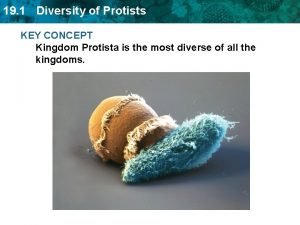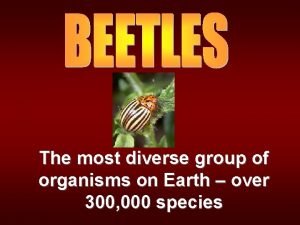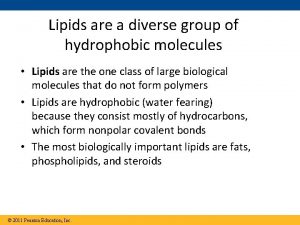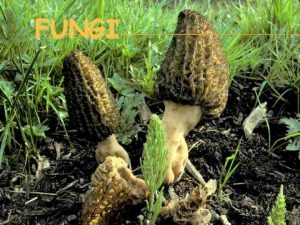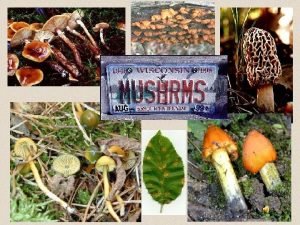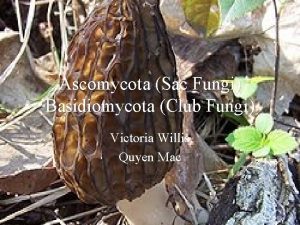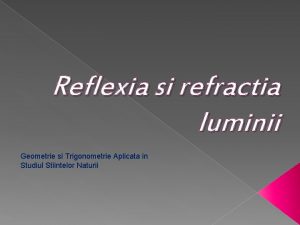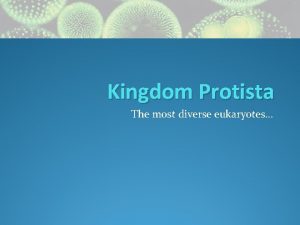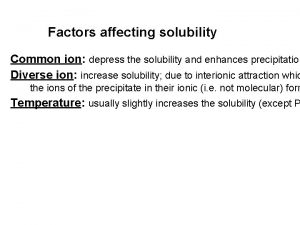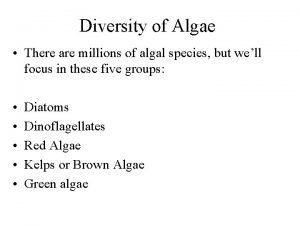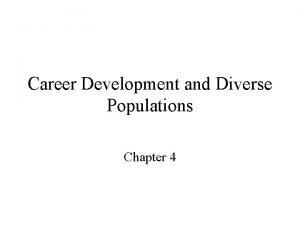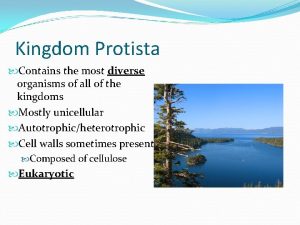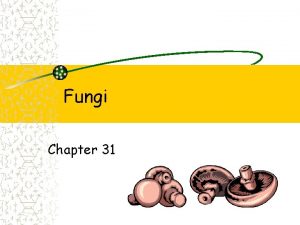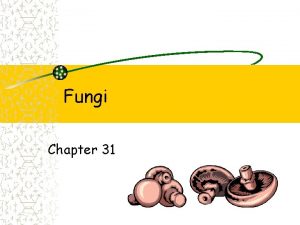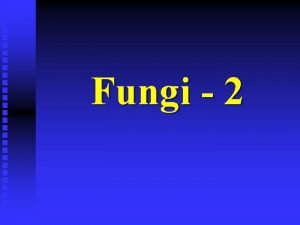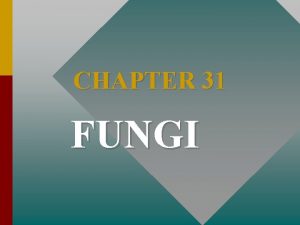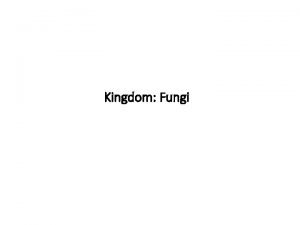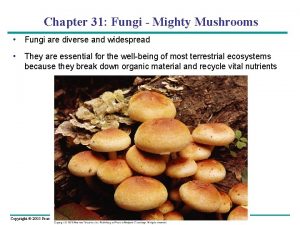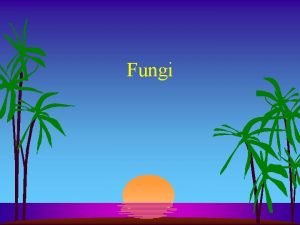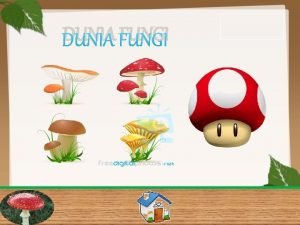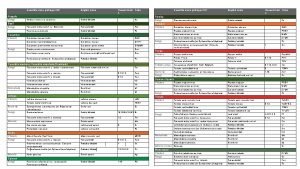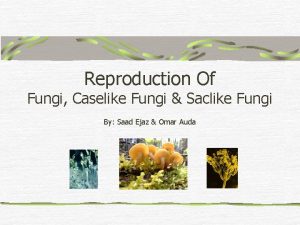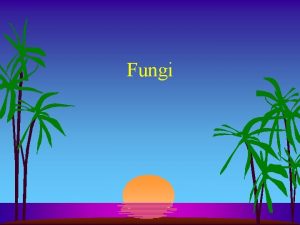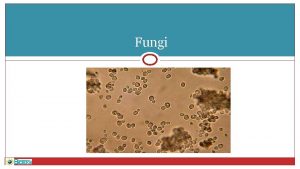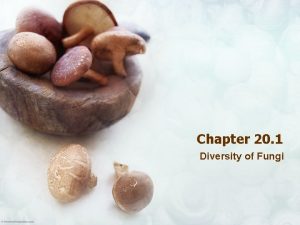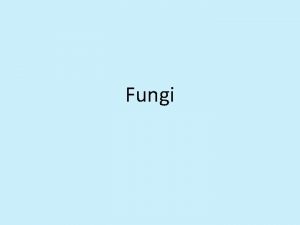Introduction Fungi Fungi comprise a diverse group of


























- Slides: 26

Introduction: Fungi • Fungi comprise a diverse group of (mostly) multicellular eukaryotes. • Fungi feed by absorbing nutrients from living or dead organisms. – important decomposers, because of their unique ability to absorb the cellulose and lignin that comprise wood. © 2011 Pearson Education, Inc.

Introduction • Some fungi absorb nutrients from their hosts, lowering the hosts’ fitness and so acting as parasites. • Most fungi that live in association with other organisms, however, benefit their hosts and are mutualists. • The roots of virtually every land plant are colonized by mutualistic fungi. In exchange for sugars synthesized by the plant, the fungi provide the plant with water and key nutrients without which the host plants grow more slowly or even starve. © 2011 Pearson Education, Inc.

Introduction • Fungi can be thought of as the master traders and recyclers in terrestrial ecosystems; some fungi release nutrients from dead plants and animals; others transfer nutrients they obtain to living plants. © 2011 Pearson Education, Inc.

Why Do Biologists Study Fungi? • Fungi nourish the plants that nourish us. • They affect global warming, because they are critical to the carbon cycle on land. • A handful of species can cause debilitating diseases in humans and crop plants. © 2011 Pearson Education, Inc.

Importance: Fungi Provide Nutrients for Land Plants • Mycorrhizal associations between fungi and plant roots allow faster plant growth. – Experiments show that plant growth suffers in the absence of these fungi. © 2011 Pearson Education, Inc.

Importance: Fungi Speed the Carbon Cycle on Land • Saprophytes are fungi that make their living by digesting dead plant material. • The carbon cycle on land has two basic components: 1. The fixation of carbon by land plants. 2. The release of CO 2 from plants, animals, and fungi as the result of cellular respiration. • For most carbon atoms, fungi connect the two components, as they are the organisms that break down the complex molecules in wood into reusable organic compounds. © 2011 Pearson Education, Inc.

© 2011 Pearson Education, Inc.

Fungi Have Important Economic Impacts • Although parasitic fungi cause athlete’s foot, vaginitis, diaper rash, ringworm, pneumonia, and thrush in humans, the incidence of fungal infections in humans is relatively low. • Fungi have many beneficial impacts on humans. – Fungi are the source for many antibiotics, including penicillin. – Many cultures eat mushrooms. – We have used yeast for thousands of years to make bread, cheese, soy sauce, tofu, beer, wine, and other foods. © 2011 Pearson Education, Inc.

Fungi Have Important Economic Impacts • The major destructive impact of fungi is on crops. – Fungi are responsible for fruit and vegetable spoilage. – Fungi are the cause of several epidemics that have killed millions of trees, such as chestnuts and elms. © 2011 Pearson Education, Inc.

How Do Biologists Study Fungi? • About 80, 000 species of fungi have been described and named; about 1000 more are discovered each year. • The known species are widely regarded as a tiny fraction of the real total, estimated at 1. 65 million species or even more. © 2011 Pearson Education, Inc.

Analyzing Morphological Traits • Fungi have very simple bodies. Two growth forms exist: 1. Single-celled forms— yeasts. 2. Multicellular, filamentous forms—mycelia. • Some fungi adopt both forms. © 2011 Pearson Education, Inc.

The Nature of the Fungal Mycelium and Hyphae • All mycelia are dynamic; they constantly grow in the direction of food sources and die back in areas where food is running out. • The filaments that make up a mycelium are called hyphae • Hyphae may be haploid or heterokaryotic, containing several haploid nuclei from different parents. – Most heterokaryotic hyphae are dikaryotic, with two haploid nuclei, one from each parent. © 2011 Pearson Education, Inc.

The Nature of the Fungal Mycelium and Hyphae • Each filament is separated into cell-like compartments by cross-walls called septa. – Gaps in septa called pores enable materials to flow between compartments • Some fungi are coenocytic, meaning they lack septa entirely. • Hyphae are exceedingly thin, allowing fungal mycelia to penetrate tiny fissures in soil and absorb nutrients that are inaccessible to plant roots. © 2011 Pearson Education, Inc.

Mycelia Have a Large Surface Area • Because mycelia are composed of branching networks of very thin hyphae, the body of a fungus has the highest surface-area-tovolume ratio observed in a multicellular organism. • This makes absorption extremely efficient but also makes fungi prone to drying out. • Mycelia are an adaptation to the absorptive lifestyle of fungi. Thus, reproductive organs—not feeding structures—are the only thick, fleshy structures that fungi produce. – Reproductive spores are resistant to drying out. © 2011 Pearson Education, Inc.

Evaluating Molecular Phylogenies • Fungi are more closely related to animals than to land plants. – Fungal infections in humans are more difficult to treat than bacterial infections. Recent shared ancestry results in similar cellular and molecular structures—drugs that affect fungal structures may similarly affect human structures. • Evidence for this relationship includes: – DNA sequence data. – Both animals and fungi synthesize chitin. – Chytrid animal flagella are similar in structure and function. – Both groups store glucose as glycogen. © 2011 Pearson Education, Inc.

© 2011 Pearson Education, Inc.

Experimental Studies of Mutualism • Fungi and land plants often have a symbiotic relationship—one of close association. Several types of symbiosis are found. • Mutualism is a symbiotic relationship that provides benefits to both species involved. • In a parasitic symbiotic relationship, one species benefits at the expense of the other. • In a commensal relationship, one species benefits while the other is unaffected. • Experimental evidence indicates that mycorrhizal fungi and plants are mutualistic. © 2011 Pearson Education, Inc.

Mutualisms with Other Species • Lichens are a mutualistic partnership between a species of ascomycete and either a cyanobacterium or an alga. • Some ant species actively farm fungi inside their colonies. The ants fertilize and “weed” the fungal gardens, then harvest the fungi for food. © 2011 Pearson Education, Inc.

Why Are Fungi Effective Decomposers? • Although bacteria and archaea are also important decomposers in terrestrial environments, fungi and a few bacterial species are the only organisms that can digest wood completely, due to two adaptations: 1. The large surface area on the mycelium enhances absorption. 2. Saprophytic fungi are able to grow toward the dead tissues that supply their food. © 2011 Pearson Education, Inc.

Extracellular Digestion Instead of digesting food inside a stomach or food vacuole, as most animals and some protists do, respectively, fungi synthesize digestive enzymes and then secrete them outside their hyphae, into their food. – This process is called extracellular digestion. • Basidiomycetes can completely degrade both lignin and cellulose, components of woody cells. © 2011 Pearson Education, Inc.

Spores as Key Reproductive Cells • The spore is the most fundamental reproductive cell in fungi. – They are the dispersal stage in the fungal life cycle and are produced in huge numbers during both asexual and sexual reproduction. • If a spore falls on a food source and is able to germinate, a mycelium begins to form. As the fungus expands, hyphae grow in the direction in which food is most abundant. © 2011 Pearson Education, Inc.

Spores as Key Reproductive Cells • If food begins to run out, the mycelium responds by making spores, which are dispersed by wind or animals. • Spore production allows starving mycelia to disperse offspring to new habitats where more food might be available. © 2011 Pearson Education, Inc.

Multiple Mating Types • In many fungal lineages, hyphae come in different mating types rather than morphologically distinct sexes. – Hyphae of the same mating type will not combine during sexual reproduction. • In this way, mating types function as sexes. Instead of having just two sexes, a single fungal species may have tens of thousands. • Having multiple mating types helps generate genetic diversity in offspring. © 2011 Pearson Education, Inc.

How Does Fertilization Occur? Only members of the Chytridiomycota produce gametes, and no fungus produces gametes that are different enough in size to be called sperm and egg. • In many fungi, fertilization occurs in two steps, which can be separated in both time and space: 1. Fusion of cells. 2. Fusion of nuclei from the fused cells. © 2011 Pearson Education, Inc.

How Does Fertilization Occur? • The process of sexual reproduction begins when hyphae from two individuals fuse to form a hybrid hypha. Plasmogamy occurs when the cytoplasms fuse. • If the nuclei remain independent, the mycelium becomes heterokaryotic. • Karyogamy occurs when the nuclei fuse to form a diploid zygote. © 2011 Pearson Education, Inc.

© 2011 Pearson Education, Inc.
 Diverse diverse
Diverse diverse What comprise a community
What comprise a community A cohesive marketing mix and the related budget comprise
A cohesive marketing mix and the related budget comprise You are a very smart girl tammy tells her daughter
You are a very smart girl tammy tells her daughter Possibly synoynm
Possibly synoynm Most diverse group of organisms
Most diverse group of organisms Diverse group of hydrophobic molecules
Diverse group of hydrophobic molecules Club fungi are morels truffles bracket fungi yeast
Club fungi are morels truffles bracket fungi yeast Deuteromycetes
Deuteromycetes Club fungi
Club fungi Propagarea luminii in diverse medii
Propagarea luminii in diverse medii The most diverse eukaryotic kingdom is
The most diverse eukaryotic kingdom is What is online platforms sites and content
What is online platforms sites and content Parlamentarismo compromissorio
Parlamentarismo compromissorio Diverse ion effect
Diverse ion effect Algal diversity
Algal diversity African iron age
African iron age Pilot nav sid
Pilot nav sid Career development of diverse populations
Career development of diverse populations Art is diverse
Art is diverse La somma delle altezze di un parallelogramma
La somma delle altezze di un parallelogramma We live in a diverse world
We live in a diverse world Chapter 16 section 2 transcaucasia
Chapter 16 section 2 transcaucasia Circus possessive form
Circus possessive form What is the most diverse kingdom
What is the most diverse kingdom Sexual reproduction
Sexual reproduction Trends in ict assistive media
Trends in ict assistive media
